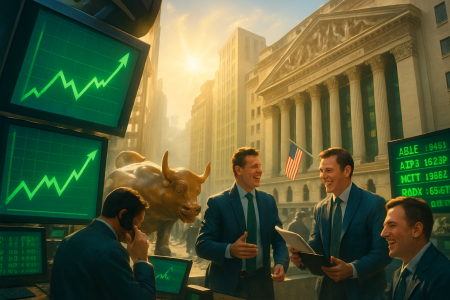Wall Street has been riding a remarkable wave in 2025 — record-breaking indexes, soaring investor confidence, and a tech-fueled rally that’s defied repeated predictions of slowdown. The bulls are back, or so it seems. Yet behind the glowing green tickers and celebratory headlines, an undercurrent of unease runs deep. Inflation remains stubborn in parts of the economy, the Federal Reserve’s next move hangs in uncertainty, and global geopolitical tensions continue to send ripples through markets.
So, the question becomes — can this rally last, or is Wall Street’s momentum skating on thin ice?
📈 The Rally That Refused to Fade
At first glance, the numbers tell an undeniably optimistic story. The S&P 500 surged to new all-time highs, powered by heavyweight tech stocks, resilient consumer spending, and renewed investor faith in the American economy. The NASDAQ, too, has seen its best first-half performance in nearly a decade, driven by AI, semiconductor innovation, and a rebound in risk appetite.
The key driver? Optimism rooted in innovation. Artificial intelligence, automation, and clean technology are fueling what many analysts are calling the “Second Tech Supercycle.” Companies like Nvidia, Microsoft, and Amazon continue to dominate investor portfolios — not just as growth stories, but as bellwethers of a new economic era.
As Ryan McCarthy, chief strategist at Morningline Capital, puts it:
“Wall Street isn’t just betting on quarterly earnings anymore — it’s betting on the architecture of the future. AI and automation are no longer buzzwords; they’re the new GDP drivers.”
💡 The Economic Paradox: Growth Amid Tightening
Yet, this rally comes against a backdrop that seems almost paradoxical. The Federal Reserve remains cautious, inflation is cooling but not conquered, and borrowing costs are still higher than they’ve been in years.
Typically, rising rates would cool markets. But 2025 has defied those norms. Why? Because corporate balance sheets are stronger than expected, consumer spending remains resilient, and job markets — though cooling slightly — haven’t collapsed.
Still, cracks are visible. Small-cap stocks are lagging behind, wage growth has plateaued, and corporate earnings forecasts for the second half of the year are increasingly conservative. Even as markets climb, economists warn that this rally is running on selective strength — not broad-based growth.
Economist Dana Liu explains it succinctly:
“It’s not that the economy is bulletproof; it’s that investors are being selective. They’re piling into what looks safe — megacaps, tech, defense — and ignoring the rest.”
🌎 The Global Picture: A Fragile Financial Web
What happens beyond Wall Street could be just as critical. Europe faces persistent energy uncertainty, China’s post-pandemic recovery has stumbled, and emerging markets are struggling under the weight of a strong dollar.
For global investors, diversification once meant safety — but in 2025, interconnectedness has become a double-edged sword. The health of the U.S. economy remains intertwined with global supply chains, commodity prices, and geopolitical dynamics. Any disruption — from Middle East instability to trade restrictions — could swiftly jolt investor confidence.
Meanwhile, central banks across continents are attempting to choreograph a “soft landing,” balancing growth with inflation control. But history rarely grants many soft landings, and markets know it.
💥 The Risk Factors Lurking Beneath the Rally
Despite the market’s current exuberance, several warning lights are flashing.
- Inflation’s Stubborn Persistence – While consumer inflation has cooled, core inflation — particularly in housing and services — remains sticky. If prices rise again, the Fed may have little choice but to tighten policy further, potentially triggering a correction.
- Corporate Earnings Compression – Earnings beats have kept investors confident, but margins are under pressure from rising input costs, slower hiring, and global supply chain reconfigurations.
- Debt and Deficits – The U.S. federal debt has surpassed $35 trillion, and interest payments are now among the largest items in the federal budget. Higher debt servicing costs could force tough fiscal choices that ripple through the private sector.
- Investor Psychology – The rally’s momentum has created pockets of speculation reminiscent of previous bubbles. The fear of missing out (FOMO) is driving behavior in sectors like AI and EVs, which could make markets more vulnerable to sentiment shifts.
⚖️ The Fed’s Tightrope Walk
The Federal Reserve remains at the center of this balancing act. Having raised rates aggressively over the past two years, the Fed now faces a dilemma: ease too soon, and inflation may flare again; tighten too long, and growth could stall.
So far, Chair Jerome Powell has emphasized data dependence, but investors are already pricing in potential cuts by late 2025. That optimism could be premature. The bond market, often a better predictor of economic reality than equities, suggests caution — with an inverted yield curve persisting longer than expected.
If rate cuts come later or slower than Wall Street hopes, the resulting correction could test even the most bullish portfolios.
💬 The Sentiment Shift: Confidence or Complacency?
Investor sentiment is a strange beast — it can buoy markets to irrational heights and, with one shock, send them tumbling. Right now, optimism reigns, but complacency may be creeping in. The VIX, often called the “fear index,” remains at unusually low levels, indicating that investors are underpricing risk.
There’s a growing sense that the market may be “priced for perfection.” Any deviation — weaker earnings, a surprise Fed announcement, or geopolitical shock — could trigger a sharp pullback.
And yet, history shows that rallies like this can persist longer than skeptics expect. The market’s resilience is often less about logic and more about liquidity, confidence, and narrative — three things Wall Street has in abundance right now.
🔮 The Long View: Where Does This Rally Go From Here?
In the long term, the fundamentals of the American economy still appear strong. Innovation, consumer demand, and capital investment continue to provide a solid foundation. If inflation continues to ease and productivity gains from AI and technology materialize, the current rally could indeed sustain — albeit with occasional turbulence.
But investors would be wise to remember that momentum is not immunity. Every bull run eventually meets its correction, and those who recognize the early signs are often the ones who thrive in the aftermath.
In many ways, 2025’s rally mirrors the dual nature of modern markets — buoyant on technology and optimism, yet fragile under policy and perception.
🧭 Conclusion: Riding the Wave, Watching the Wind
Wall Street’s current momentum reflects both genuine economic progress and speculative enthusiasm. It’s a rally built on innovation and faith — but faith is a volatile currency. The coming months will test whether this optimism can weather headwinds like inflation, global instability, and policy uncertainty.
For now, investors continue to ride the wave. But as any seasoned market watcher knows, the winds can shift without warning.
In the end, the story of this rally won’t be written in charts or tickers — it will be written in how resilient investors remain when the headlines turn red instead of green.



